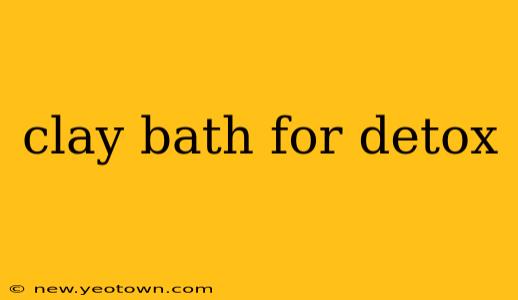For centuries, the earth’s bounty has offered a pathway to wellness, and among its gifts, clay stands out as a potent detoxifying agent. Clay baths, a practice steeped in ancient traditions, are experiencing a resurgence, promising a natural and rejuvenating way to cleanse the body and mind. But what’s the science behind this earthy elixir? And are clay baths truly effective for detoxification? Let’s unearth the answers.
My journey into the world of clay baths began with a simple question: could something so natural be truly effective at detoxifying my body? I’d felt sluggish, stressed, and my skin was looking dull. After researching extensively and consulting with a holistic wellness practitioner, I decided to give it a try. What I discovered was more than just a relaxing soak; it was an experience that left me feeling refreshed, rejuvenated, and deeply connected to nature. This is my story, and hopefully, it will answer your questions too.
What are the benefits of a clay bath for detoxification?
Clay, particularly bentonite clay, is rich in minerals like magnesium, calcium, and potassium. These minerals are believed to draw out impurities from the body through a process called adsorption. Imagine the clay acting like a magnet, attracting toxins from your skin and leaving you feeling cleaner and lighter. Many believe that this detoxification extends beyond the skin, impacting the body's overall well-being. While more research is needed to definitively prove this, anecdotal evidence and traditional practices strongly support the benefits.
How does a clay bath work for detoxification?
The magic lies in the clay's negative ionic charge. Toxins in our bodies often carry a positive charge. This opposition of charges allows the clay to attract and bind to these toxins, effectively removing them from the body through the skin. This process isn't solely about removing toxins; it's also about supporting the body's natural detoxification pathways, encouraging cellular regeneration, and improving overall skin health.
What are the different types of clay used in detox baths?
Several types of clay boast detoxifying properties, each with its unique mineral composition and benefits:
- Bentonite Clay: Highly absorbent and widely popular for its detoxifying capabilities.
- Rhassoul Clay: Known for its gentle cleansing and moisturizing properties, ideal for sensitive skin.
- Kaolin Clay: A milder clay, often used for its soothing and calming effects.
What are the side effects of a clay bath?
While generally safe, clay baths can have potential side effects. Some people might experience skin irritation or dryness, especially if they have sensitive skin. It's always best to do a patch test before a full bath to check for any adverse reactions. Additionally, some clays can stain light-colored tubs, so be mindful of this. Always choose a high-quality, food-grade clay to minimize risks.
How often should I take a clay bath for detox?
The frequency depends on individual needs and preferences. Some people find one or two baths a week sufficient, while others may benefit from more frequent use. Listen to your body – if you feel any irritation, reduce the frequency. Consistency is key, but moderation is equally important.
Can I add essential oils to my clay bath?
Absolutely! Adding essential oils can enhance the therapeutic benefits of your clay bath. Lavender for relaxation, tea tree for its antiseptic properties, or eucalyptus for respiratory support – the possibilities are endless. Remember to use only a few drops to avoid irritation.
What should I do after a clay bath?
After your detoxifying soak, rinse thoroughly with warm water. Follow up with a gentle moisturizer to rehydrate your skin. You might feel a bit tired after the bath; this is normal as your body is working to eliminate toxins. Drink plenty of water to support your body's natural detoxification process.
My personal experience with clay baths has been transformative. The feeling of deep relaxation, combined with the belief that I’m supporting my body's natural detoxification processes, is invaluable. While scientific evidence is still emerging, the tradition, anecdotal evidence, and the immediate feeling of well-being make clay baths a compelling addition to a holistic wellness routine. But remember, it's always wise to consult with your healthcare provider before starting any new wellness practice.

